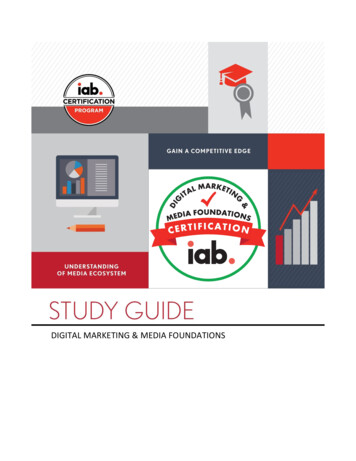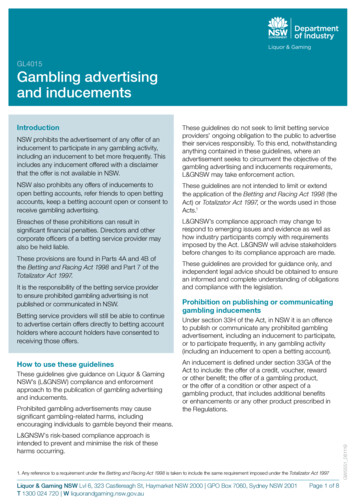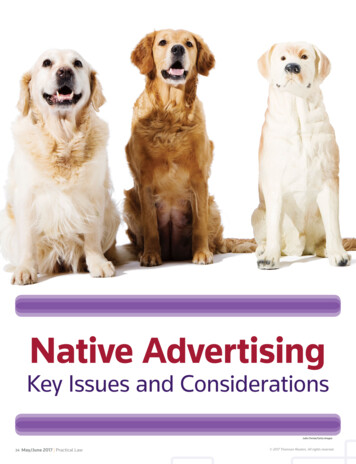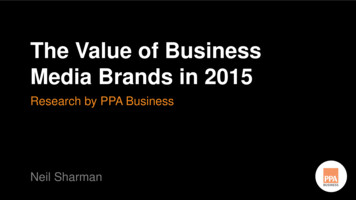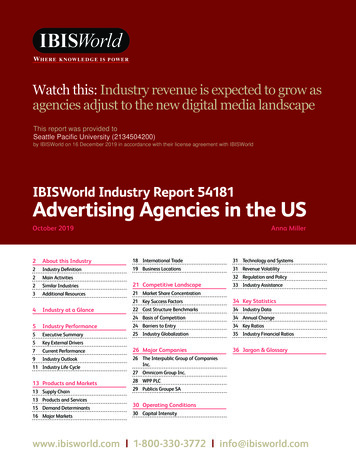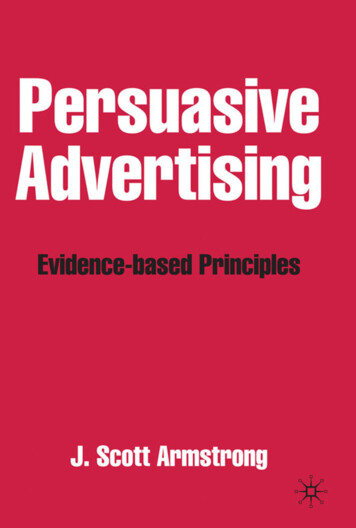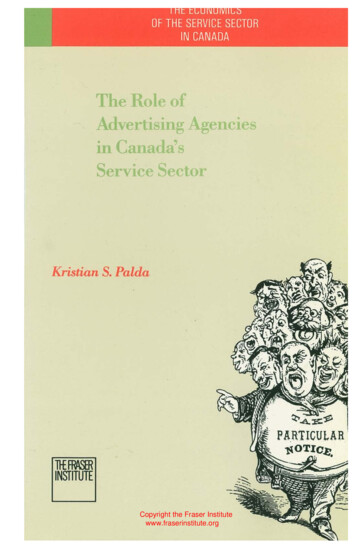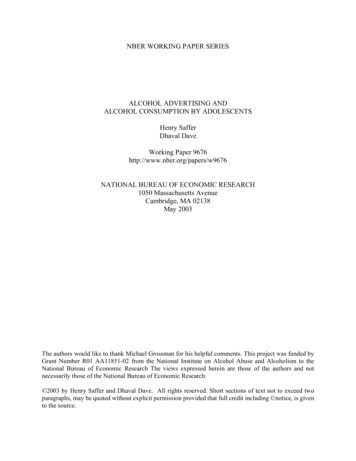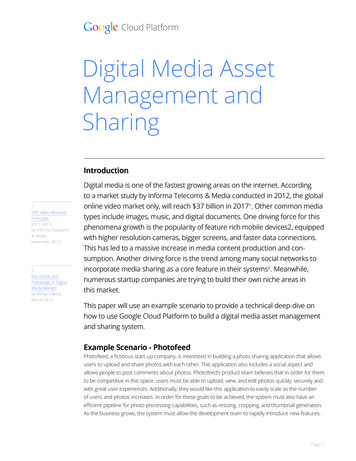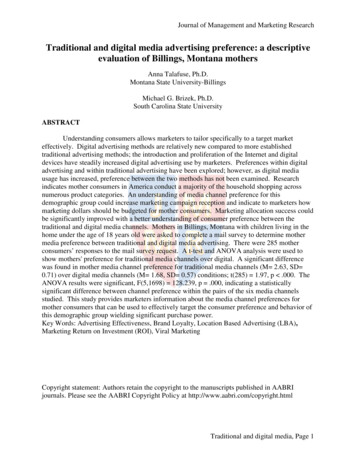
Transcription
Journal of Management and Marketing ResearchTraditional and digital media advertising preference: a descriptiveevaluation of Billings, Montana mothersAnna Talafuse, Ph.D.Montana State University-BillingsMichael G. Brizek, Ph.D.South Carolina State UniversityABSTRACTUnderstanding consumers allows marketers to tailor specifically to a target marketeffectively. Digital advertising methods are relatively new compared to more establishedtraditional advertising methods; the introduction and proliferation of the Internet and digitaldevices have steadily increased digital advertising use by marketers. Preferences within digitaladvertising and within traditional advertising have been explored; however, as digital mediausage has increased, preference between the two methods has not been examined. Researchindicates mother consumers in America conduct a majority of the household shopping acrossnumerous product categories. An understanding of media channel preference for thisdemographic group could increase marketing campaign reception and indicate to marketers howmarketing dollars should be budgeted for mother consumers. Marketing allocation success couldbe significantly improved with a better understanding of consumer preference between thetraditional and digital media channels. Mothers in Billings, Montana with children living in thehome under the age of 18 years old were asked to complete a mail survey to determine mothermedia preference between traditional and digital media advertising. There were 285 motherconsumers’ responses to the mail survey request. A t-test and ANOVA analysis were used toshow mothers' preference for traditional media channels over digital. A significant differencewas found in mother media channel preference for traditional media channels (M 2.63, SD 0.71) over digital media channels (M 1.68, SD 0.57) conditions; t(285) 1.97, p .000. TheANOVA results were significant, F(5,1698) 128.239, p .000, indicating a statisticallysignificant difference between channel preference within the pairs of the six media channelsstudied. This study provides marketers information about the media channel preferences formother consumers that can be used to effectively target the consumer preference and behavior ofthis demographic group wielding significant purchase power.Key Words: Advertising Effectiveness, Brand Loyalty, Location Based Advertising (LBA),Marketing Return on Investment (ROI), Viral MarketingCopyright statement: Authors retain the copyright to the manuscripts published in AABRIjournals. Please see the AABRI Copyright Policy at http://www.aabri.com/copyright.htmlTraditional and digital media, Page 1
Journal of Management and Marketing ResearchBACKGROUNDConsumer media channel preference has continued to be debated by marketers, as manymarketers have switched from traditional advertising allocation to digital or have increased theirInternet advertising spending in response to the rising costs of traditional advertising incomparison (Chao et al., 2012). Although consumer preference does not remain static, researchon consumer media channel preference has been limited (Chao et al., 2012).With 78.6% of the U.S. population using the Internet ("Internet World Stats", 2014),phenomenal growth has occurred in digital media. Advertising revenue from the Internet peakedin the third quarter of 2012 with revenues of 9.26 billion, marking an 18% increase overprevious years ("Internet Advertising Revenues", 2012). This growth includes social networkingsites like Facebook.com, Twitter.com, personal blogs, and has fueled the continued digitaladvertising growth ("Consumers Driving, 2010"; "U.S. 2010 Digital", 2011). Facebook, themost popular social networking site, is also the most visited site on the web, passing bothGoogle.com and MySpace.com in 2010 (Lipsman, 2010). Facebook advertising revenueincreased 35.9% from 2011 to 2012 and surpassed growth expectations in 2013 ("eMarketer",2012). Facebook.com earned a staggering revenue of 6.99 billion for advertising in 2013,increasing total revenue by 55% over the previous year (Edwards, 2014). A significant portionof Facebook.com's popularity and new account growth is derived from mother consumers whoaccounted for 36 million Facebook.com users as of February 2010 (as cited in Bohan, 2010). Amore conservative number was estimated in 2012 research by eMarketer with 28 million momsusing social media, and approximately 82% of those mother social media users have children inthe home under 18 years old ("Marketers", 2012). Mothers check Facebook more frequentlythan other users within a 24 hour time period and are more likely to use wireless devices to checkFacebook content ("Moms and Media", 2012).Marketing research focusing on mothers makes sense for several reasons. The totalpopulation is comprised of over 50% females who make 80% of the purchases (Banyte, et al.,2007). Women control 85% of consumer purchases ranging from vehicles to health care, withwomen controlling over 90% in categories such as new home purchases, vacations, and food("Marketing to Women", n.d.; Williams, 2010). The amount of household spending controlledby mothers is estimated at 85% (Bailey, n.d.) and includes additional product categoriescompared to purchases made by females without children. This segment offers additionalpotential for marketing researchers due to substantial purchase power and control coupled withthe responsibility of a wide range of purchases (Banyte et al., 2007; "Marketing to Women", n.d.;Williams, 2010).A new marketing strategy is necessary to target women consumers. Advertisingcampaigns where the product is merely advertised in a pink color is not an effective promotionalcampaign successful in reaching women (Costa, 2010). An online study in the United Kingdomshowed 80% of polled mothers would not make a purchase before consulting other mothersusing the site (Costa, 2010). Understanding mother media preference and external influences isimportant to understanding what will be effective with this target market group (Belch & Belch,2011).It is important for marketers to know the influence digital media has on mothers tounderstand the return-on-investment (ROI) for digital advertising campaigns. A 2010 RAMAstudy showed that e-mail advertising and online communities are similar in influence for bothgenders; however, males who used social media were more likely to be influenced by (1) InternetTraditional and digital media, Page 2
Journal of Management and Marketing Researchadvertising, (2) instant messaging, and (3) blogs ("Social Media", 2010). A more completepicture can be provided by a preference study including both digital and traditional mediaadvertising rather than preference studies within each media channel. Understanding thiscomplete picture will ensure marketers understand consumer preference and how to capturemother consumer attention with advertising geared specifically towards their preferred method ofadvertising communication.STATEMENT OF THE PROBLEMPreferences within digital advertising and within traditional advertising have beenexplored; however, "academic research that focuses on comparisons between traditional mediaand online advertising is limited, and it may take some years before significant researchpublications are available" (Chao et al., 2012, p. 21). Chao(2012) suggested that additionalresearch is necessary to further understand consumer advertising preferences in relation topredicting effectiveness of the media channel used, understanding age or generational differencesthat might exist, and examining potential shifts in preference. The Internet, or online media, fallsunder the spectrum of digital media (Karimova, 2011), and the comparison of different mediachannels is scarce (Wakolbinger, Denk, & Oberecker, 2009). Thus, media channel preferencebetween digital and traditional media channels is currently unknown for a powerful consumersegment of mother consumers (Danaher & Rossiter, 2011; Pookulangara & Natesan, 2010). Dueto a responsibility for a wide range of purchases, massive purchase power, inclination to passalong word of mouth (WOM), and increasing online presence, mother consumer mediapreference is significant to marketers (Banyte et al., 2007; Copeland, 2009; Costa, 2010; Gordon,2009; Phelps, Lewis, Mobilio, Perry, & Raman, 2004). The first half of 2011 showed consistentgrowth in e-commerce spending with approximately 1 discretionary spending of every 10spent online, remaining constant during the recent recession ("comScore Reports", 2011).Mothers self-reported the Internet as the most essential medium to everyday life (DeCesare,2011). Compared to the general population they spend more time online, and they have anincreased propensity towards Smartphone ownership that allows marketers the potential foradditional digital access to this consumer group (DeCesare, 2011). Social media continues toincrease with mothers as well, with 62% of all mothers with a Facebook.com account (DeCesare,2011). Without an understanding of mother preference between traditional and digital channels,marketers may forfeit significant sales revenue and potentially misallocate marketing dollars.The allocation of marketing dollars to unsuccessful campaigns or the use of unproductivechannels for a target market results in ineffectively spent advertising dollars and decreasedpotential sales revenue. Advertising expenditures increased to 144 billion in 2011, up .8% from2010 ("Kantar Media", 2012). Consequently, effective strategies for reaching target audiencescontinues to be of the highest importance, especially for target audiences with the purchasingpower and range of purchases of mother consumers.PURPOSE OF THE STUDYThe goal of this quantitative descriptive research study is to determine mother mediapreference between digital and traditional media advertising. To avoid sampling error, the studyused a purchased mail survey administered to 2,104 mothers with children living in the homeunder the age of 18. A minimum sample size of 252 was necessary for analysis determined by aTraditional and digital media, Page 3
Journal of Management and Marketing Researchpower analysis using G*Power (see Appendix A). Advertising preference for six media channelswas measured, including both digital and traditional mediums. Traditional channels includeradio and television, while digital channels measured include online webpage advertising, e-mailmessages, textf messaging, and social media advertising. The mean average of the digitalchannels and the mean average for the traditional channels are compared using an pairedsamples t-test to determine if a significant difference in advertising preference exists for themother population. The observed preference frequencies of each of the measured channels arealso compared using Analysis of Variance (ANOVA) to determine if a significant differenceexists in preference between each channel variable. An understanding of preference for motherconsumers will allow marketers to determine the best marketing budget allocation based on thepreferred channel mothers express.RESEARCH QUESTIONSThe following research questions address the Billings, Montana mother population withchildren living in the home to determine mother media channel preference between traditionaland digital media methods.Q1. Is there a significant difference in advertising preference between traditional and digitalmedia for the mother population?Q2. Is there a significant difference in advertising preference between radio, television, web, email, text messages, and social media advertising for the mother population?HYPOTHESESH10. There is no difference in preference between traditional or digital media advertising formother consumers.H1a. There is a difference in preference between traditional or digital media advertising formother consumers.H20. There is no difference in preference between radio, television, web, e-mail, text messages,and social media advertising for mother consumers.H2a. There is a difference in preference between radio, television, web, e-mail, text messages,and social media advertising for mother consumers.LITERATURE REVIEWPrevious ResearchAlthough research has indicated that traditional media is waning in comparison to digitalmedia methods, the research conducted by BIGresearch in 2008 showed no decrease in consumerinfluence in the electronic purchase category for traditional advertising (“Word of MouthInfluences”, 2008). Traditional media such as television, direct mail, and e-mail have remainedsteady influencers for consumers in making electronic purchases (“Word of Mouth Influences”,2008). In 2008, 88.9% of consumers watched television weekly, 77.9% read advertisements theyreceived in the mail, and 70.2% listened to the radio displaying a heavy exposure to traditionalmedia advertising (“Word of Mouth Influences”, 2008). In addition, consumers reportedTraditional and digital media, Page 4
Journal of Management and Marketing Researchnewspaper advertisements were more influential in 2008 compared to 2007 in both electronicand apparel purchases (“Word of Mouth Influences”, 2008).Traditional marketing focuses on consumer attitude information and mass-marketingtactics, while digital, or e-marketing, efforts use information obtained from data collectionmethods from actual consumer purchases to provide insights into consumer behavior (Mulhern,2009). The digital nature of the data provides significant insight almost instantaneouslycompared to other marketing research methods used in traditional channels (Malhotra, 2010).This data is collected over a period, and is capable of recording multiple transactions between aconsumer and a brand to provide a picture of a relationship compared to a picture of just onetransaction. Transactional theory has evolved into an exchange theory focused on consumerfeedback and preference relating to the relationship developed through past and futureexperiences and interactions between a consumer and a brand and the purchase intent theconsumer has with the brand in the future.The relational exchange theory of marketing portrays a shift away from the traditionallyaccepted one-way transaction theory of consumer marketing (Lefaix-Durand & Kozak, 2009).Transaction theory was based on planned advertising messages and mass-marketingcommunication efforts using demographic information for a target segment (Mulhern, 2009;Romaniuk & Gugel, 2010; Vargo & Lusch, 2004). Relational exchange focuses on the consumerbrand interaction and on fostering continued communication between the two (Vargo & Lusch,2004). The adaptation of relational exchange theory in marketing allows continuedcommunication between the consumer and the brand in an effort to target a consumer need moreeffectively. This communication encourages brand loyalty and consumer participation that wasunattainable with the previously supported transaction theory (Dwyer et al., 1987).Arndt (1979) described the relationship between a firm and consumer outside of thecontext of transactional theory and declared properties of a long-term relationship and the effectson consumer behavior. In the 1980s, marketers determined that consumer behavior and loyaltyto a firm is influenced by previous interactions (Styles, Patterson, Ahmed, 2008). The primarydifferentiation between the two exchange theories is the interconnected, personal, and customercentered, communication between the firm and customer (Schakett, 2009).Media channels using relational marketing techniques employ a prolongedcommunication between the firm and consumer instead of the short transaction time-periodrepresentative of transactional theory (Dwyer, et al., 1987). The development of a relationshipseparate from the confines of the singular transaction emphasizes the relational aspect of theinitial transaction and creation of perceptions that influence the probability of repeat transactions.The determination of future consumer purchases is based on customer perceptions founded ontrust between the consumer and firm (Dwyer et al., 1987; Morgan & Hunt, 1994).Starting in the 1990s, the adoption of global economic activity and technologicaladvances like the Internet and handheld wireless devices increased the ability and frequency ofrelational exchanges between consumers and firms. This new technology allowed marketers toreach consumers with advertising data and picture content without regard to the current physicallocation of the consumer or the specific time of day (Mulhern, 2009). The interaction and twoway communication have led many to claim that the Internet is more effective than traditionaladvertisements (Chen, 2006). The digitization of media content and the resulting network effectshave broadened the reaches of relational theory and have also instilled a new user-control overmarketing messages that was absent in transactional theory (Mulhern, 2009).Traditional and digital media, Page 5
Journal of Management and Marketing ResearchStrategies for relational theory only work with the two-way communication instead of thepush marketing used in traditional marketing channels. Without the permission or opt-in fromconsumers, there is no two-way communication. A focus on convenience and benefit value forthe consumer can increase the likelihood that consumers will participate, which in turn willincrease the overall success of the campaign (Ashley, Noble, Donthu, & Lemon, 2011).The new user-control of interaction accompanies the premise of a consumer focus inrelational theory (Mulhern, 2009). Advertising designed using relational exchange theoryfocuses on the customer and their individual needs. The advertisements are requested by theconsumer and the content is matched directly to criteria outlined by the consumer (Mulhern,2009). Relational exchange theory is grounded on commitment and trust as the basis of theexchange process between firms and consumers. Consumers expect to be consulted to determinewhat marketing messages they will receive and how they will receive those messages.Relational exchange increases the likelihood of advertising effectiveness through control offeredand customer focus. The tailored advertising success of a campaign intended for one individualis directly measurable by the firm.Sales performance is also affected by the number of individuals who decide to opt-in andparticipate in relational marketing practices; consumer participation is necessary for the two-waycommunication and therefore paramount to the success of the campaign using relationaltechniques (Ashley et al., 2011). A firm can control some of the factors that affect theconsumer's decision to participate in relational marketing programs such as the inconvenience toparticipate and the benefits the consumer will gain by participating (Ashley et al., 2011). Otherfactors outside the control of the firm include the frequency the consumer shops at a store oflocation, their involvement with the brand, and importantly-privacy concerns involving theirparticipation (Ashley et al., 2011).Measurement tools have shown marketing executives the exact cost in marketingallocation to obtain a new customer (Schakett, 2009). The purpose of relational marketing is tofoster a positive, lasting relationship with the consumer in efforts to create customer loyalty(Schakett, 2009). This customer loyalty decreases overall advertising expenses for a firm, ascustomer procurement for replacement of a customer is more costly than customer retention(Tehrani, 2008). A relationship to foster customer loyalty can be developed through digitalmeans emphasizing customer satisfaction with online purchases and translates into loyalty to theonline retailer (Kim, Kim, & Kandampully, 2009).Consumer SegmentationMarketing theory has historically included what marketers refer to as the Four P's ofmarketing (product, price, place, and promotion) and the use of mass marketing implementation(Malhotra, 2010). Digital advertising, or new media, has increased the ability of marketers totarget smaller segments of consumers with specified interests or purchase behavior rather than touse the blanket advertising method for large consumer groups (Truong et al., 2010). This hasallowed Internet advertising, which largely began in 1994, to become a major advertisingmedium (Taylor, 2009).As digital marketing, or e-marketing, is the primary method used in relationship buildingwith consumers, an understanding of e-marketing is essential. A digital presence in a globalmarketplace allows marketers to communicate with a larger segment of the selected targetmarket. Studies have shown digital advertising efforts that emphasize interactivity are moreTraditional and digital media, Page 6
Journal of Management and Marketing Researchsuccessful than non-interactive online advertising formats (Taylor, 2009). Interactivity is used inrelational theory to maintain continuous communication between marketing executives andconsumers, build relationships, and increase customer loyalty (Martin & Todorov, 2010).An increasing use of the Internet has decreased overall consumer attention to traditionalmarketing channels in a majority of product categories (Copeland, 2009). A direct relationshipexists between digital media and paid search, signifying that digital media marketing offers avaluable role in gaining consumer attention, engaging consumers, and driving sales (Copeland,2009). Brand messages become less important as decisions are aided with digital methods suchas word of mouth (WOM) and other advertising mediums (Andjelic, 2010).A study recently found that marketing managers measure online and offlineadvertisements differently (Cheong et al., 2010). Compared to 1994 findings, the 2010 studyshows how offline media advertisements focus primarily on reach and frequency, while onlinemedia focuses primarily on click-through-rates, unique visitors to a page, number of page views,and ad impressions to make media evaluations (Cheong et al., 2010). Measuring click-throughrates (CTR) and new membership quantitative data to gauge advertising success is an example ofa potential research method used to gauge advertising success in the online context (Pfeiffer &Zinnbauer, 2010). Measurement using CTR and new membership works well for businessesoperating solely in an online context, but fails to measure all variables of success for brick andmortar locations or businesses with both storefronts and digital operations (Pfeiffer & Zinnbauer,2010).Researchers have suggested that for businesses with online operations and no physicalstorefront, the singular use of online marketing campaigns can be successful only once the brandhas gained recognition and brand awareness (Pfeiffer & Zinnbauer, 2010). Traditional methodsare necessary to obtain recognition and brand awareness, at least initially, for a business toremain successful (Pfeiffer & Zinnbauer, 2010). Despite the observation about different lifecycle stages of a brand needing different advertising methods and the need for businesses to useboth traditional and digital advertising channels, researchers have not determined which methodcontinues to be the most successful advertising channel. Software programs to observeconsumer behavior in response to e-marketing in the online environment lack the comparison fortraditional advertising effectiveness (McMahan, Hovland, & McMillan, 2009). One reason isthat although the software is very successful in measuring variables such as CTR or newmembers in the online context, offline measurement is conducted differently and often notdirectly comparable.Observation measures actual purchases, while purchase intent needs to be measured usingother methods. Purchase intent can also play a very important role in measuring the success of amarketing campaign, as purchases may not take place immediately after the consumer views orhears the advertising. Latent purchases derived from marketing messages and brand awarenesscampaigns can be considered successful. Observation techniques in a lab setting can weaken thevalidity of the measurement as respondents do not always react and behave the same inlaboratory settings, as they know they are being watched. This is true of laboratory setting usingsoftware to track consumer purchase behavior in simulated settings as well (McMahan et al.,2009).Other external factors can affect the success of an advertising campaign. Competitoradvertising can effectively increase or decrease another firm’s sales (Pfeiffer & Zinnbauer,2010). For online advertising, the weather and holiday schedules affected the amount of timeconsumers spend online, which increased the amount of time consumers viewed advertisingTraditional and digital media, Page 7
Journal of Management and Marketing Researchcontent (Pfeiffer & Zinnbauer, 2010). Consumers spend less time online when the weather isnice and more time online around holidays (Pfeiffer & Zinnbauer, 2010).Research in Malaysia using undergraduates as research participants has shown adifference in media preference between male and females (Omar et al., 2010). In addition,although television was found to be the most available media to this demographic group studied,the results indicated that these young Malaysian adults preferred online media (Abidin, Omar,Mahmud, Rosli, & Rahman, 2011). Media preference was found to have a significantrelationship with lifestyle factors such as family background, standard of living, and access to theInternet (Abidin et al., 2011).Not all research indicates greater consumer influence from digital media. Twointernational studies reported higher influence from traditional media compared to other digitalmedia options. Australian participants over 18 years old who own cell phones and have dailyInternet access preferred traditional advertising to new media (Danaher & Rossiter, 2011). Inaddition, a New Zealand study of participants ranging from 14 to 30 years old concluded that46% of the participants preferred advertising received by television, 5% preferred onlineadvertisements, and 2% preferred SMS text messaging advertisements (as cited in Danaher &Rossiter, 2011). However, consumers are not always influenced primarily by one medium.Young adults, individuals between 18 and 34 years old, watch television and surf the websimultaneously approximately 45% of the time (“Word of Mouth Influences”, 2008). This samedemographic group will watch television and listen to the radio or engage in other activitiesabout one fourth of the time (“Word of Mouth Influences”, 2008).The decline of traditional marketing is reiterated in 2009 when approximately 400magazines and 140 newspapers stopped publishing while only a few transferred to a purelyonline format (Zillman, 2010). However, examples of digital and traditional media operatingtogether effectively can be found. Research into digital and traditional print newspapers foundthat the cannibalistic effects of traditional media becoming ineffective with the introduction ofdigital newspapers could be avoided because many readers use print and digital newspapers fordifferent reasons (Flavian & Gurrea, 2009). Digital newspapers were used by readers to obtainup to date information rather than waiting until the following day for all news or the breakingnews of the day (Flavian & Gurrea, 2009). Avoidance of this cannibalistic effect as described bythe authors is currently possible and expected in the future as well.Traditional and digital channels are accepted as distinct from one another (Danaher &Rossiter, 2011; Pookulangara & Natesan, 2010) with traditional marketing methods in declineaccording to conventional wisdom. Despite the anecdotal wisdom, 47% of U.S. small businessesdo not use digital media advertising methods (Barone, 2011). Some researchers propose thattraditional methods are initially necessary for brand awareness and recognition for a business toachieve success (Pfeiffer & Zinnbauer, 2010). Other research has suggested that digitaladvertising is in fact bigger than traditional marketing and is "increasingly woven into the fabricof our business and consumer culture" ("Razorfish Outlook Report", 2011, p. 5). Conflictingexpectations for media channel dominance and consumer preference necessitates research onconsumer media preference between traditional and digital media advertising.Further investigation of traditional and digital media channels may provide additionalinformation into past research findings as well as provide future implications for the currentpreference study. The proposed research plan will explore consumer preference between the twomedia channels, which use different exchange theories, to examine whether a model can bedeveloped to assist marketers in determining how to best advertise to mothers with childrenTraditional and digital media, Page 8
Journal of Management and Marketing Researchliving in the home. The insight gained from this data and potential understanding gained from adeveloped model would assist in suggesting how marketers should advertise to motherconsumers.Digital and Traditional ChannelsTelevisionTelevision is one form of traditional media using one-way communication methods. Intelevision advertising, marketing messages provide a message to the consumer with no possiblecommunication return method from the consumer. The effectiveness of television advertising isquestioned based on a few reasons, (1) the availability of devices such as DVR and Tivorecording devices that allow consumers to skip commercials by fast forwarding, (2) consumeradmissions that they prefer programming without commercials and avoid them, (3) advertisinglength in a one hour program has increased in the past 50 years, and (4) consumers aresimultaneously watching television and multi-tasking and do not fully focus on program contentor advertisements during the program (Rubinson, 2009).Multitasking consumers is not a
predicting effectiveness of the media channel used, understanding age or generational differences that might exist, and examining potential shifts in preference. . Is there a significant difference in advertising preference between radio, television, web, e-mail, text messages, and social media advertising for the mother population? HYPOTHESES
